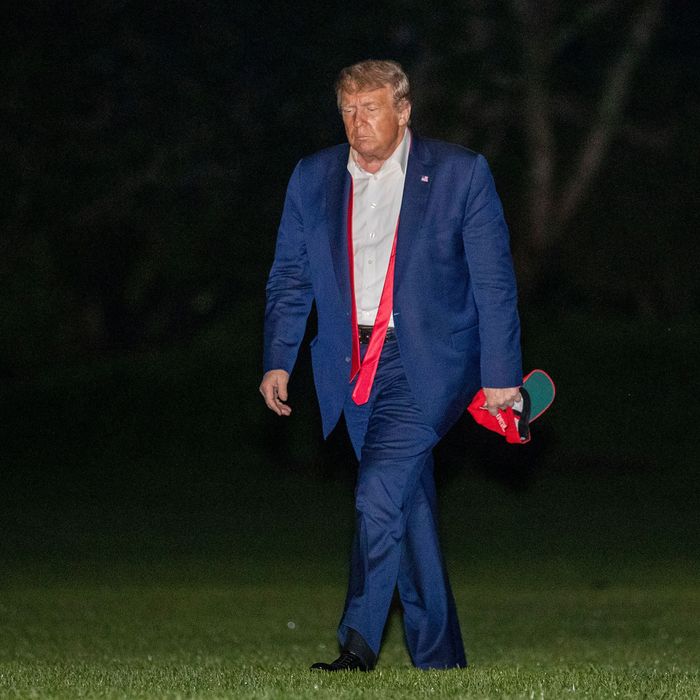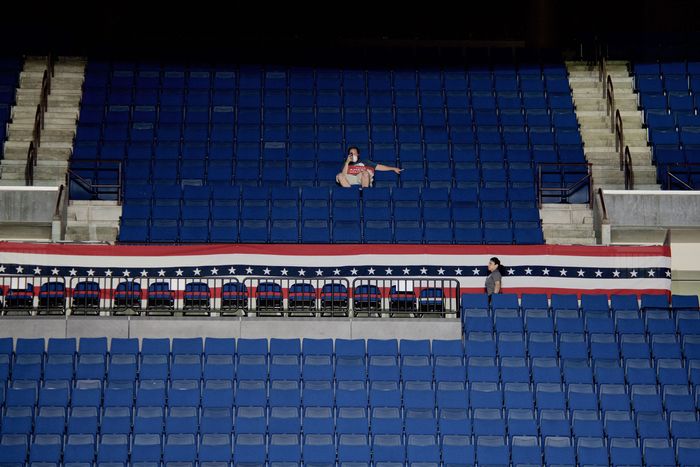
In a year of unforgettable images — from hospital workers battling a pandemic, to the murder victim George Floyd, to toppled Confederate memorials, and many more — a sea of empty blue seats at the Bank of Oklahoma Center in Tulsa on June 20 may seem less than iconic. But it could tell us a lot about the current trajectory of this year’s high-stakes presidential election.
An estimated 6,200 people showed up in the 19,000-seat arena for the Trump reelection campaign’s first rally since the coronavirus pandemic began, and plans for speeches by Trump and Mike Pence in an overflow area outside the venue obviously had to be canceled. Some blame — or credit — for all of those empty seats was attributable to K-Pop fans, TikTok users, and other anti-Trump pranksters ordering tickets to an event they had no intention to attend. But as my colleague Chas Danner explained, this was one of many, many reasons the rally was a logistical and visual fiasco for Team Trump.
But the key question is whether this was just a bad moment for Trump-Pence 2020, or an indicator of bad times to come. Here are some reasons to reach the latter conclusion.
1. Tulsa was evidence of an incompetent campaign.The very first rule of political advance work is that you never ever book a venue you are not certain you will fill. That’s particularly true if you work for Donald J. Trump, who just moved his party’s national convention from Charlotte to Jacksonville to ensure that he would have a packed house of excited supporters present when he gives his nomination-acceptance speech in August.
The idea that a bunch of teenagers on social media were able to thwart plans for a rally being staged by the well-financed and experienced Trump reelection campaign should be even more depressing to the president and his partisans. Before Tulsa, it was entirely possible to project that in a very close election, the money and experience possessed by Brad Parscale and his team (which did, after all, guess right on its strategic decisions down the stretch in 2016) could be the tiebreaker. That they couldn’t stage a successful event in deep-red Oklahoma that was intended to represent the starting gun for the general-election campaign is a terrible indicator of incompetence.
2. The rally sent the wrong message for Trump about his battle against the coronavirus.The intended significance of the Tulsa rally wasn’t just that Trump was holding a big, live, indoor event as soon as he possibly could. It was supposed to be the first of many victory rallies, as Greg Sargent succinctly explains:
This rally was meant to “reset” a much larger story line: It was supposed to reinforce and embody the notion that Trump has defeated coronavirus, that the country is roaring back to greatness, and that Trump is soaring to reelection on the wings of those triumphs.
It was, in short, the embodiment of the “comeback” story on which Trump has staked so very much now that “his” beautiful economy has been ruined and public assessments of his handling of the pandemic have turned negative.
If fear of infection dissuaded tens of thousands of big-time, red-hat-wearing Trump fans in a state he won by 36 points from attending an event meant to show the whole world that America was “reopening,” what does that say about the status of Trump’s fight against the “Kung Flu,” as he called it in a racist neologism in Tulsa? It sent the opposite message from the one he intended.
3. Are Trump supporters afraid of protesters?Aside from coronavirus fears, Parscale offered another interesting excuse for low attendance, according to the New York Times:
“The fact is that a week’s worth of the fake news media warning people away from the rally because of Covid and protesters, coupled with recent images of American cities on fire, had a real impact on people bringing their families and children to the rally,” he said.
Think about that excuse for a moment in terms of what it says about the self-confidence for which MAGA people are famous. If the Trump phenomenon means anything at all beyond savage partisanship, it stands for the vengeful defiance of “political correctness,” and a triumphant rejection of claims that America’s not the white Christian homeland it used to be. Trump’s ascent meant that the “silent majority” no longer had to fear those people — the black and brown folk, the immigrants, the feminists, the Muslims, and all the protesters generated by such groups. Yet three and a half years into Trump’s presidency, his campaign manager is telling us that his core supporters are afraid to attend an event in the cocoon of all the massive security that accompanies a POTUS event.
That’s not the in-your-face racism that Trump has so often inspired in his most loyal supporters. They seem to lack the old esprit de corps.
Normally I’d be the last political observer to make a big deal out of “enthusiasm” indicators like rally attendance, or yard signs, or people telling pollsters they are psyched out of their skulls about voting. But there has never in recent memory been a presidential candidacy that depends so very much on “base enthusiasm.” It is practically the only thing Trump seems to care about in making presidential decisions. And you can make a case that at a time when pandemic fears and his own party’s voter-suppression efforts have made voting more difficult than usual, Trump has an ace in the hole in a voting base that is going to show up to smite the fake media and the elites and those people come hell or COVID-19.
Precisely because he values enthusiasm so much, signs of its absence like those displayed in Tulsa are a big, blinking danger sign for Trump’s reelection prospects. As Danner put it, the rally was intended to serve as a “cure-all spectacular” for his campaign. It was anything other than that.
5. Without rallies, Trump is a shell of his former self.It’s no secret that Donald Trump loves campaign rallies more than the presidency itself. And these typically wild events have importance in binding him to his supporters, particularly in so-called “flyover country” presumably despised by the coastal elites that despise the president as well. As David Smith observed at a West Virginia rally after a particularly bad week for Trump in 2017, Trump rallies create their own world:
As the crowd whooped in awe and admiration, it was hard to believe the president’s worst week — the collapse of healthcare legislation, his communications director uttering profanities and later departing, wayward tweets about transgender troops — had ever actually happened. Offering drama, swagger and the illusion of certainties in an uncertain world, the rallies are vital in sustaining this alternate reality.
Possibly, the Tulsa debacle may have been just a hiccup, and soon Trump’s campaign will regain its mojo and he’ll go back to holding rallies in venues packed with bright, white, unmasked faces. If not, it’s hard to imagine how the whole Trump show will go on.
"really" - Google News
June 23, 2020 at 02:08AM
https://ift.tt/2Z1ofSP
The Tulsa Rally Was a Really Bad Sign for Trump - New York Magazine
"really" - Google News
https://ift.tt/3b3YJ3H
https://ift.tt/35qAk7d
Bagikan Berita Ini















0 Response to "The Tulsa Rally Was a Really Bad Sign for Trump - New York Magazine"
Post a Comment